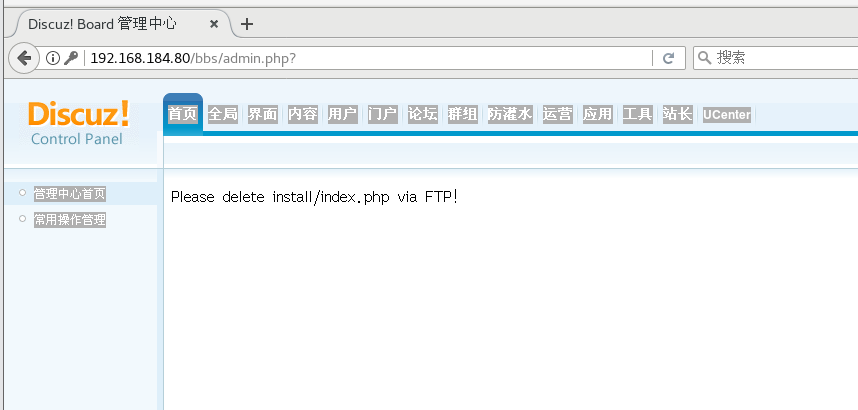1. What is LAMP
1.1 introduction to lamp
LAMP architecture is one of the mature enterprise website application modes at present. It refers to a complete set of systems and related software working together, which can provide static and dynamic web site services and its application development environment. Specifically, it includes Linux operating system, Apache Web server, MySQL database server, PHP (or Perl, Python) web programming language.
1.2 description of all components
Linux (platform): as the basis of LAMP architecture, it provides the operating system used to support the Web site, which can provide better stability and compatibility with the other three components (AMP components also support Windows, UNIX and other platforms).
Apache (foreground): as the front end of LAMP architecture, it is a powerful and stable Web server program. The server directly provides users with website access, sending Web pages, pictures and other file contents.
**MySQL (background): * * as the back end of LAMP architecture, it is a popular open source relational database system. In enterprise websites, business systems and other applications, various account information, product information, customer information and business data can be stored in MySQL database. Other programs can query and change these information through SQL statements.
**PHP/Perl/Python (intermediate connection): as three programming languages for developing dynamic Web pages, it is responsible for interpreting dynamic Web page files, communicating the Web server and database system to work together, and providing the development and running environment of Web applications** PHP is a widely used open source multi-purpose scripting language, which can be embedded in HTML, especially suitable for Web application development.
The installation sequence is Linux, Apache, MySQL and PHP in turn. The installation of PHP environment is generally put at the end, and is responsible for communicating the Web server and database system to work together.
2. Installing Apache services
2.1 turn off the firewall

2.2 installing dependent packages
yum -y install \ gcc \ #C language compiler gcc-c++ \ #C + + compiler make \ #Source code compiler (source code to binary file) pcre \ #pcre is a perl function library, including perl compatible regular expression library pcre-devel \ #perl interface development package expat-devel \ #It is used to support the website to parse HTML and XML files perl #perl compiler
2.3 transfer the software packages required to install Apache to the / opt directory
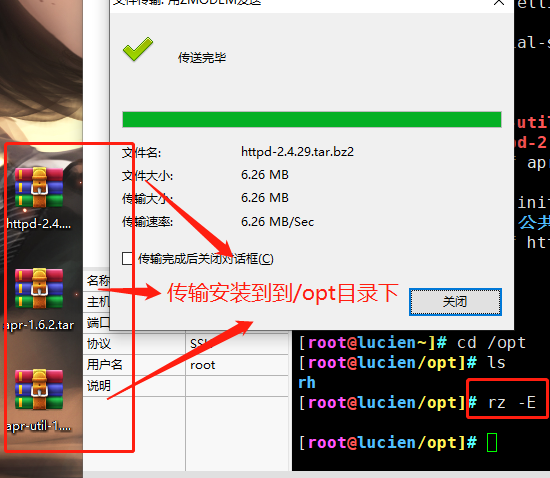
3. Install environment dependent packages
gcc #C language compiler gcc-c++ #C + + compiler make #Source code compiler (source code to binary file) pcre #pcre is a perl function library, including perl compatible regular expression library pcre-devel #perl interface development package expat-devel #It is used to support the website to parse HTML and XML files perl #perl compiler
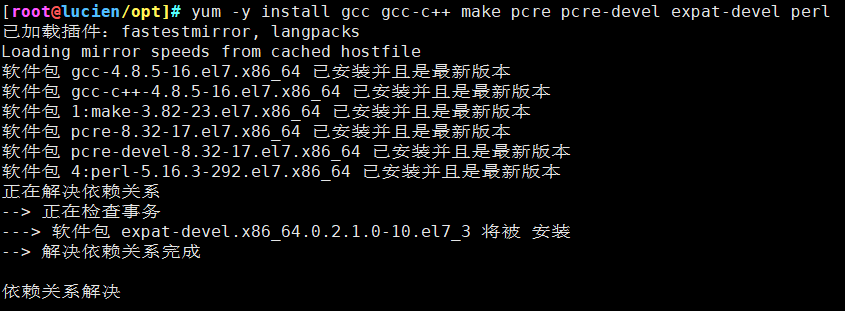
4. Unzip three compressed packages
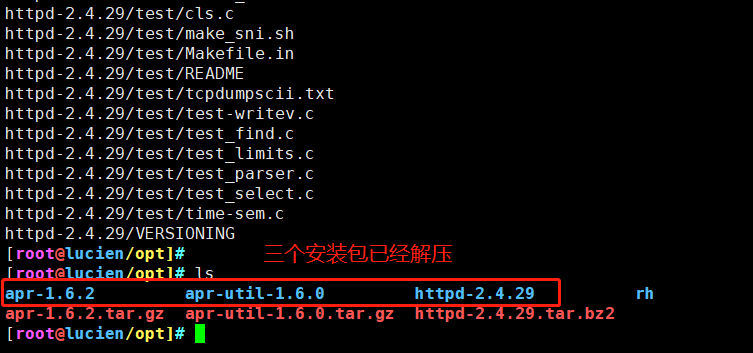
5. Configuration software module
mv apr-1.6.2 /opt/httpd-2.4.29/srclib/apr mv apr-util-1.6.0 /opt/httpd-2.4.29/srclib/apr-util cd /opt/httpd-2.4.29/ ./configure \ --prefix=/usr/local/httpd \ #Specify the path where the httpd service program will be installed --enable-so \ #Enable dynamic loading module support to enable httpd to further expand its functions --enable-rewrite \ #Enable the web address rewriting function for website optimization, anti-theft chain and directory migration maintenance --enable-charset-lite \ #Start character set support to support pages encoded with various character sets --enable-cgi #Enable CGI (general Gateway Interface) script program support to facilitate the external expansion of application access capability of the website

6. Compilation and installation
make #make -j 2 means to open 2 cores and compile at the same time make install
7. Optimize the configuration file path, and put the executable program file of httpd service into the directory of path environment variable for system identification
ln -s /usr/local/httpd/conf/httpd.conf /etc/ ln -s /usr/local/httpd/bin/* /usr/local/bin/

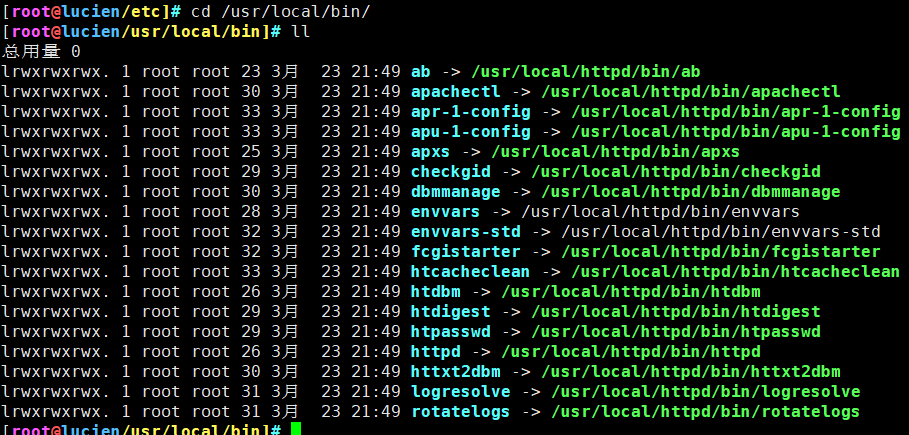
8. Add httpd system service
① Method 1:
cp /usr/local/httpd/bin/apachectl /etc/init.d/httpd #Used for service management chmod +x /etc/init.d/httpd vi /etc/init.d/httpd #!/bin/bash #Insert a new line before the first line and add these three lines # chkconfig: 35 85 21 #Level 35 automatic operation, 85th start, 21st close # description: Apache is a World Wide Web server chkconfig --add httpd #Add httpd service to service manager systemctl start httpd.service or service httpd start


② Method 2:
vim /lib/systemd/system/httpd.service [Unit] Description=The Apache HTTP Server #describe After=network.target #Describe service category [Service] Type=forking #Background operation mode PIDFile=/usr/local/httpd/logs/httpd.pid #PID file location ExecStart=/usr/local/bin/apachectl $OPTIONS #Start service ExecReload=/bin/kill -HUP $MAINPID #According to PID overload configuration [Install] WantedBy=multi-user.target systemctl start httpd.service systemctl enable httpd.service
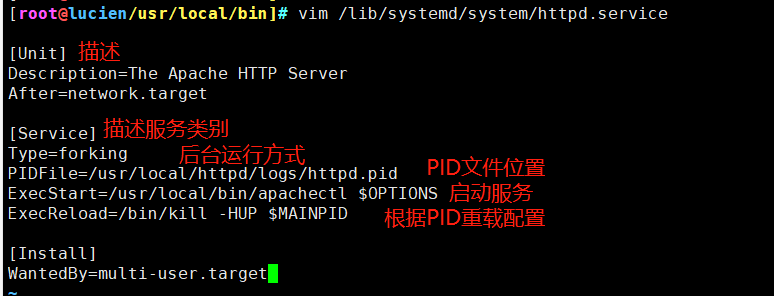
9. Modify / etc / httpd Conf service configuration file


10. Browser access verification
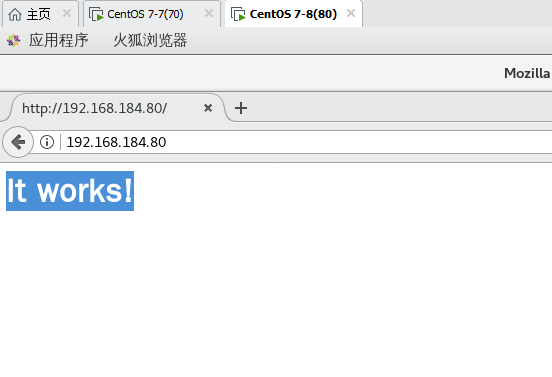
11. Use domain name access

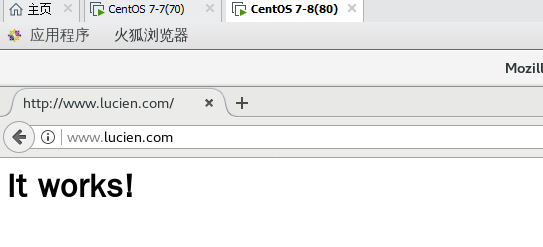
3, Manually compile mysql database
1. Transfer the software package required to install mysql to the / opt directory

2. Install environment dependent packages
yum -y install \ gcc \ gcc-c++ \ ncurses \ #Dynamic library of graphic interactive function under character terminal ncurses-devel \ #ncurses development kit bison \ #Parser cmake #mysql needs to be compiled and installed with cmake
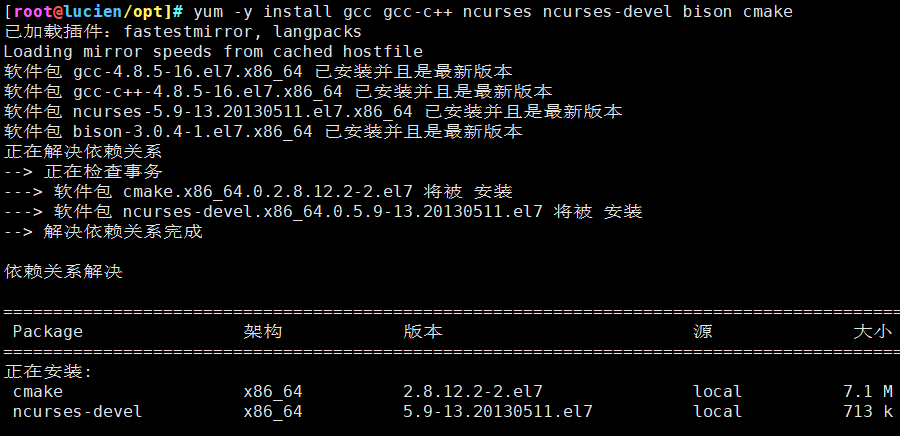
3. Configuration software module
tar zxvf mysql-5.7.17.tar.gz tar zxvf boost_1_59_0.tar.gz cd /opt mv boost_1_59_0 /usr/local/boost #rename cd /opt/mysql-5.7.17/ cmake \ -DCMAKE_INSTALL_PREFIX=/usr/local/mysql \ -DMYSQL_UNIX_ADDR=/usr/local/mysql/mysql.sock \ -DSYSCONFDIR=/etc \ -DSYSTEMD_PID_DIR=/usr/local/mysql \ -DDEFAULT_CHARSET=utf8 \ -DDEFAULT_COLLATION=utf8_general_ci \ -DWITH_EXTRA_CHARSETS=all \ -DWITH_INNOBASE_STORAGE_ENGINE=1 \ -DWITH_ARCHIVE_STORAGE_ENGINE=1 \ -DWITH_BLACKHOLE_STORAGE_ENGINE=1 \ -DWITH_PERFSCHEMA_STORAGE_ENGINE=1 \ -DMYSQL_DATADIR=/usr/local/mysql/data \ -DWITH_BOOST=/usr/local/boost \ -DWITH_SYSTEMD=1

- Storage engine options:
- MYISAM, MERGE, MEMORY, and CSV engines are compiled into the server by default and do not need to be explicitly installed.
- Statically compile a storage engine to the server, using - DWITH_engine_STORAGE_ENGINE= 1
- Available storage engine values are: archive, Blackhole, expand, federated, innobase (InnoDB), partition (partitioning support), and PERFSCHEMA (Performance Schema)
- be careful:
- If an error is reported in the process of CMAKE, after the error is solved, you need to put cmakecache in the source directory Txt file is deleted, and then CMAKE is again. Otherwise, the error remains the same
4. Compilation and installation
make && make install
- 1
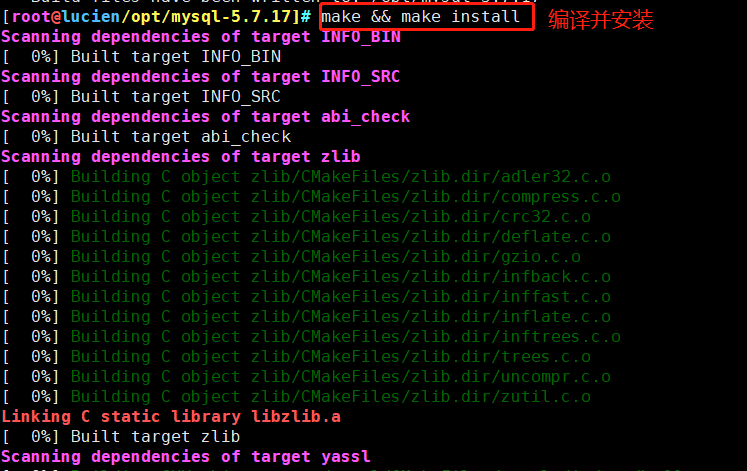
5. Create mysql user
useradd -M -s /sbin/nologin mysql
- 1
6. Modify mysql configuration file
vim /etc/my.cnf #Delete the original configuration item and add the following content again [client] #Client settings port = 3306 socket = /usr/local/mysql/mysql.sock [mysql] #Server settings port = 3306 socket = /usr/local/mysql/mysql.sock auto-rehash #Turn on the automatic completion function [mysqld] #Service global settings user = mysql #Set management user basedir=/usr/local/mysql #Specify the installation directory of the database datadir=/usr/local/mysql/data #Specify the storage path of the database file port = 3306 #Specify port character-set-server=utf8 #Set the encoding format of the server character set to utf8 pid-file = /usr/local/mysql/mysqld.pid #Specify pid process file path socket=/usr/local/mysql/mysql.sock #Specify database connection file bind-address = 0.0.0.0 #Set the listening address. 0.0.0.0 means that all IP addresses are allowed. If multiple IP addresses are allowed, they should be separated by spaces skip-name-resolve #Disable DNS resolution max_connections=2048 #Set the maximum number of mysql connections default-storage-engine=INNODB #Specify the default storage engine max_allowed_packet=16M #Set the maximum packet size received by the database server-id = 1 #Specify service ID number
7. Change the primary group of mysql installation directory and configuration file
chown -R mysql:mysql /usr/local/mysql/ chown mysql:mysql /etc/my.cnf
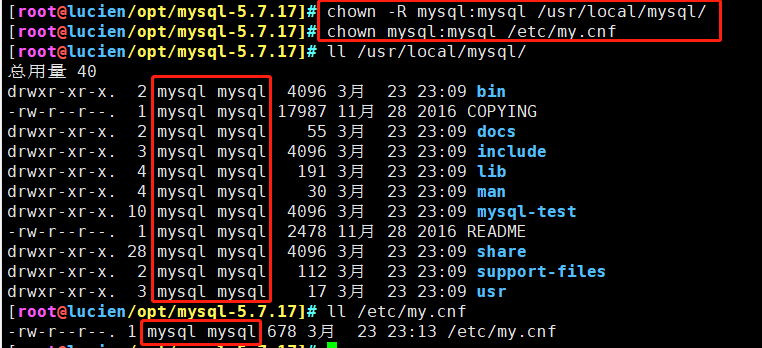
8. Set path environment variable
echo 'export PATH=/usr/local/mysql/bin:/usr/local/mysql/lib:$PATH' >> /etc/profile source /etc/profile

9. Initialize database
cd /usr/local/mysql/bin/ ./mysqld \ --initialize-insecure \ #Generation initialization password is null --user=mysql \ #Specify administrative users --basedir=/usr/local/mysql \ #Specify the installation directory of the database --datadir=/usr/local/mysql/data #Specify the storage path of the database file
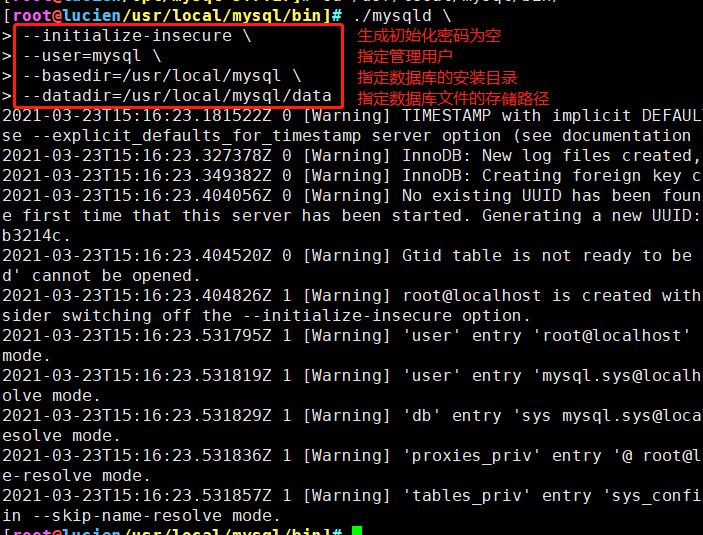
10. Add mysqld system service
cp /usr/local/mysql/usr/lib/systemd/system/mysqld.service /usr/lib/systemd/system/ #For systemctl service management systemctl daemon-reload #Refresh recognition systemctl start mysqld.service #Open service systemctl enable mysqld #Power on self start netstat -anpt | grep 3306 #View port

11. Modify the login password of mysql and authorize remote login
mysqladmin -u root -p password "abc123" #Set the password to abc123 for the root account, and the prompt is the original password (empty) mysql -u root -p grant all privileges on *.* to 'root'@'%' identified by 'abc123'; #The root user is authorized to log in remotely at all terminals with the password abc123, and has operation authority on all databases and tables show databases; #View existing databases
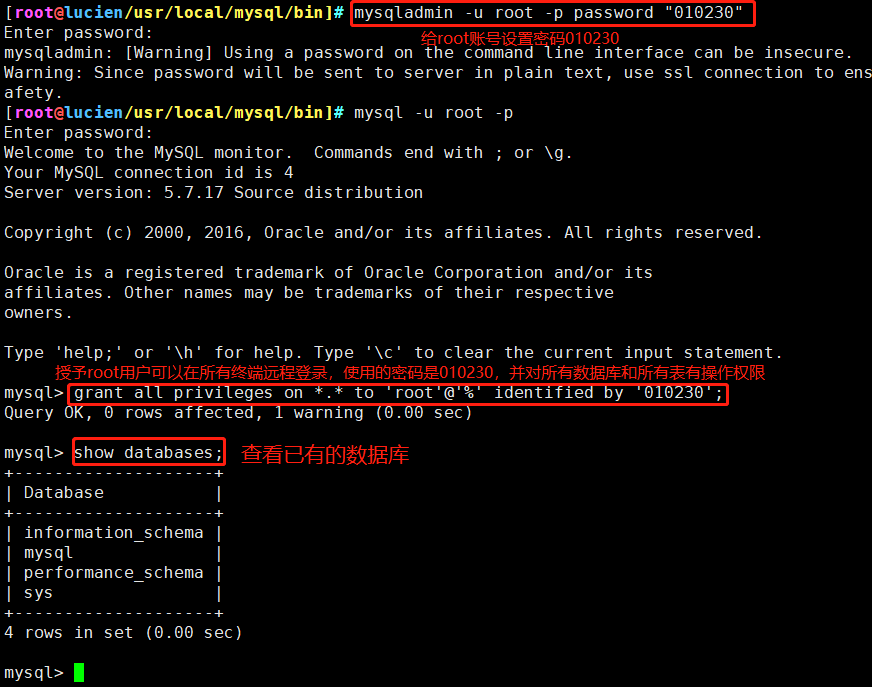
4, Manually compile and install PHP
1. Transfer the software package required to install PHP to the / opt directory
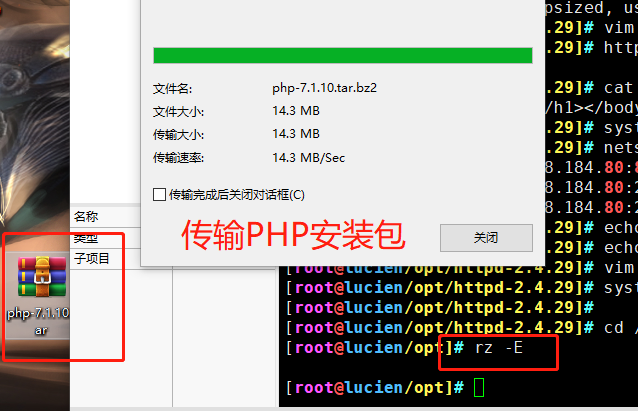
2. Install GD library and Gd library associated programs to process and generate pictures
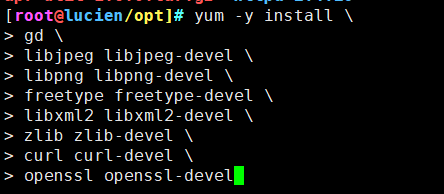

3. Configuration software module
tar jxvf php-7.1.10.tar.bz2 cd /opt/php-7.1.10/ ./configure \ --prefix=/usr/local/php7 \ #Specify the path where the PHP program will be installed --with-apxs2=/usr/local/httpd/bin/apxs \ #Specifies the file location of the apxs module support program provided by the Apache httpd service --with-mysql-sock=/usr/local/mysql/mysql.sock \ #Specify the storage path of mysql database connection file --with-config-file-path=/usr/local/php7 #Set the configuration file for PHP Where ini will be stored --with-mysqli \ #add to MySQL Extended support #mysqli extension technology can not only call MySQL stored procedures and handle MySQL transactions, but also make accessing the database more stable --with-zlib \ #Support zlib function and provide data compression --with-curl \ #Enable curl extension function to realize HTTP Get download and Post request --with-gd \ #Activate gd library support --with-jpeg-dir \ #Activate jpeg support --with-png-dir \ #Activate png support --with-freetype-dir \ --with-openssl \ --enable-mbstring \ #Enable multi byte string function to support Chinese and other codes --enable-xml \ #Open extensible markup language module --enable-session \ #conversation --enable-ftp \ #Text transfer protocol --enable-pdo \ #function library --enable-tokenizer \ #Token interpreter --enable-zip #ZIP compression format
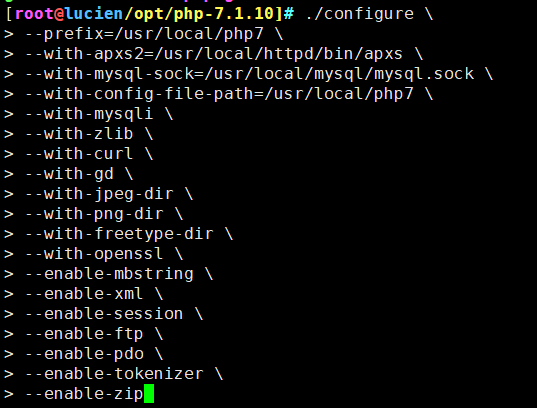

4. Compilation and installation
make && make install
- 1
5. Copy the template file as the main configuration file of PHP and modify it
cp /opt/php-7.1.10/php.ini-development /usr/local/php7/php.ini #Use PHP. PHP when testing the environment Ini development file, while using PHP in the production environment Ini production file vim /usr/local/php7/php.ini --1170 that 's ok--modify mysqli.default_socket = /usr/local/mysql/mysql.sock --939 that 's ok--Uncomment, modify date.timezone = Asia/Shanghai
6. Optimization: put PHP executable program files into the directory of path environment variables for system identification

7. Modify the configuration file of httpd service to make apache support PHP```
vim /etc/httpd.conf --393 that 's ok--Insert the following AddType application/x-httpd-php .php AddType application/x-httpd-php-source .phps --255 that 's ok--Modify home page file name settings DirectoryIndex index.html index.php
– - check whether the module supporting php7 exists – –
LoadModule php7_module modules/libphp7.so
8. Validate PHP test page
rm -rf /usr/local/httpd/htdocs/index.html #Delete default static homepage file vim /usr/local/httpd/htdocs/index.php #Write dynamic home page file <?php phpinfo(); ?> systemctl restart httpd.service #Restart service Browser access http://192.168.184.80
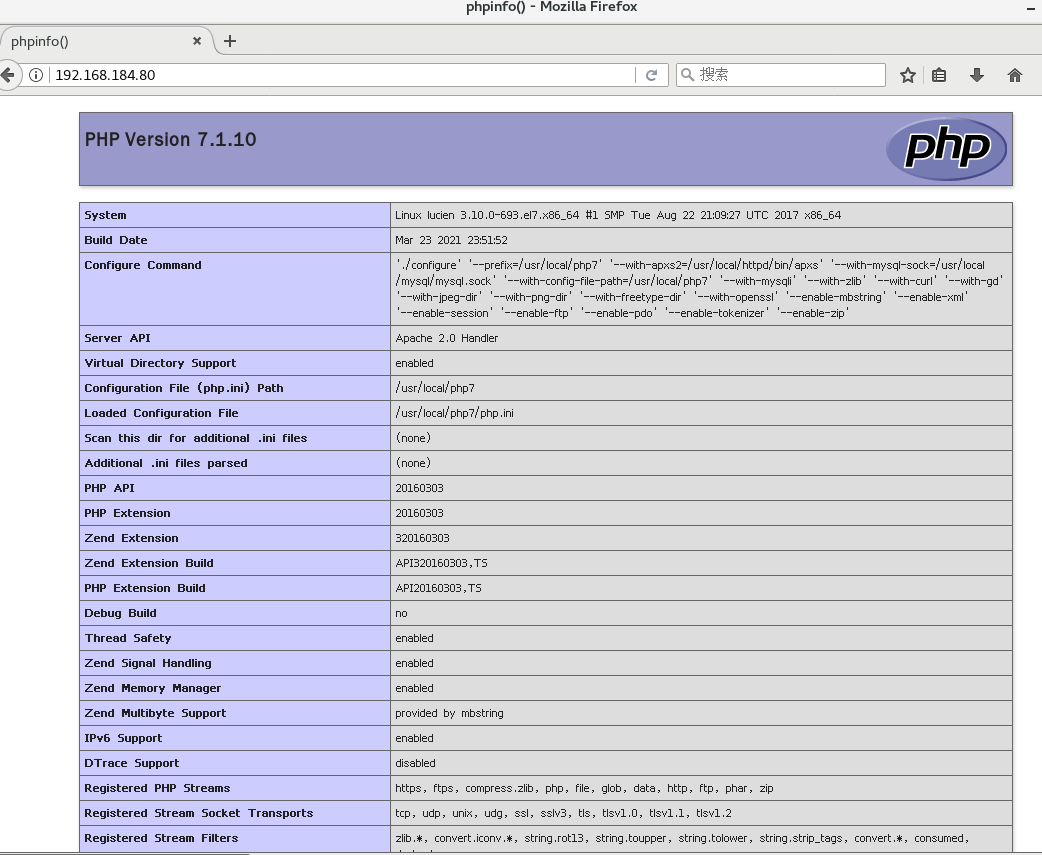
5, Use LAMP to build a forum
1. Complete the construction of LAMP
2. Create database and authorize
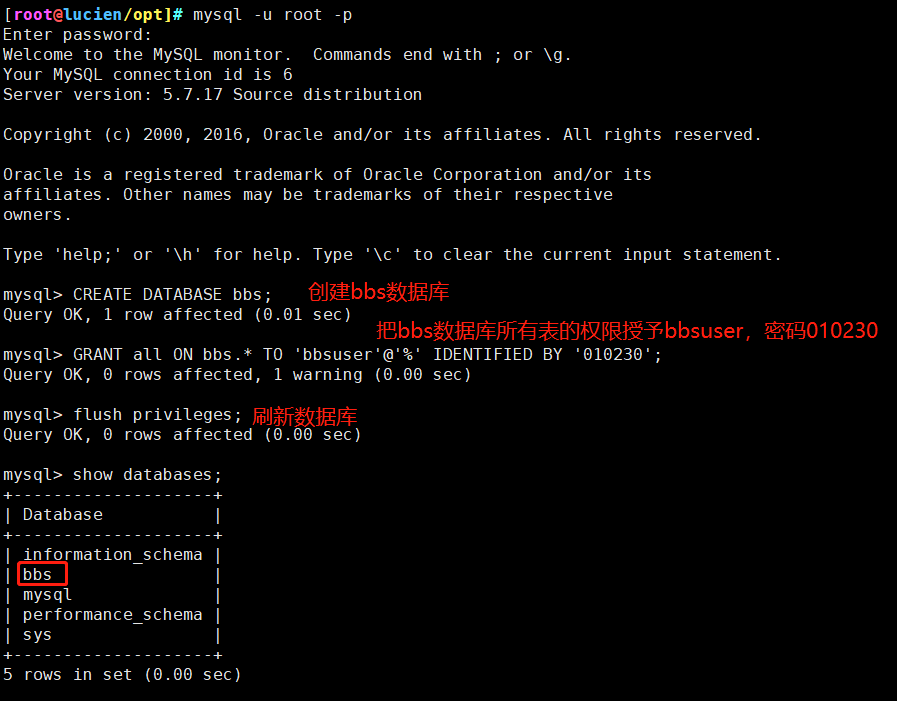
3. Upload and unzip the forum zip



4. Change the owner of the forum directory
ps aux #The user name of the forum process is daemon cd /usr/local/httpd/htdocs/bbs chown -R daemon ./config chown -R daemon ./data chown -R daemon ./uc_client chown -R daemon ./uc_server/data


5. Browser access verification
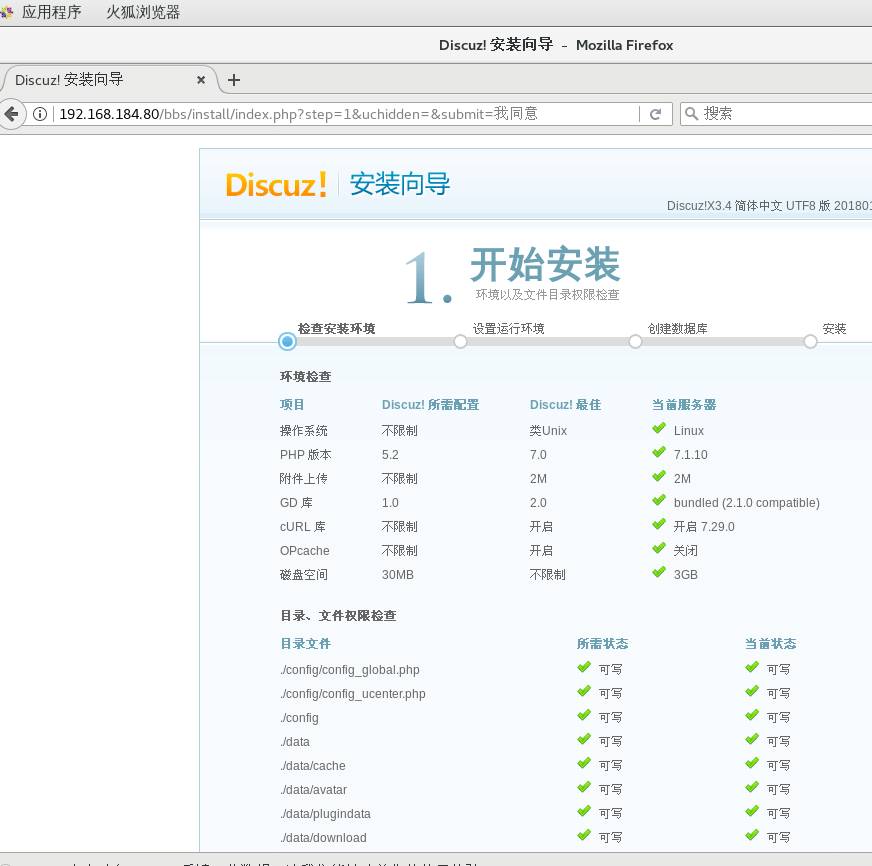
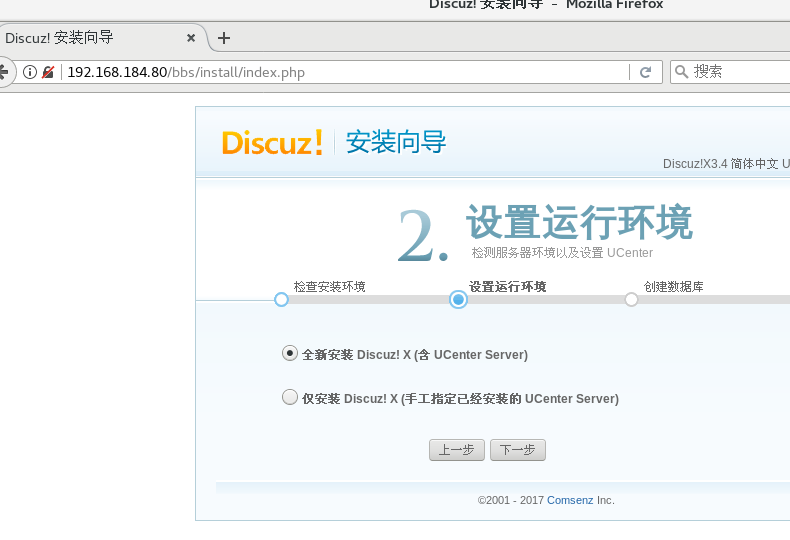
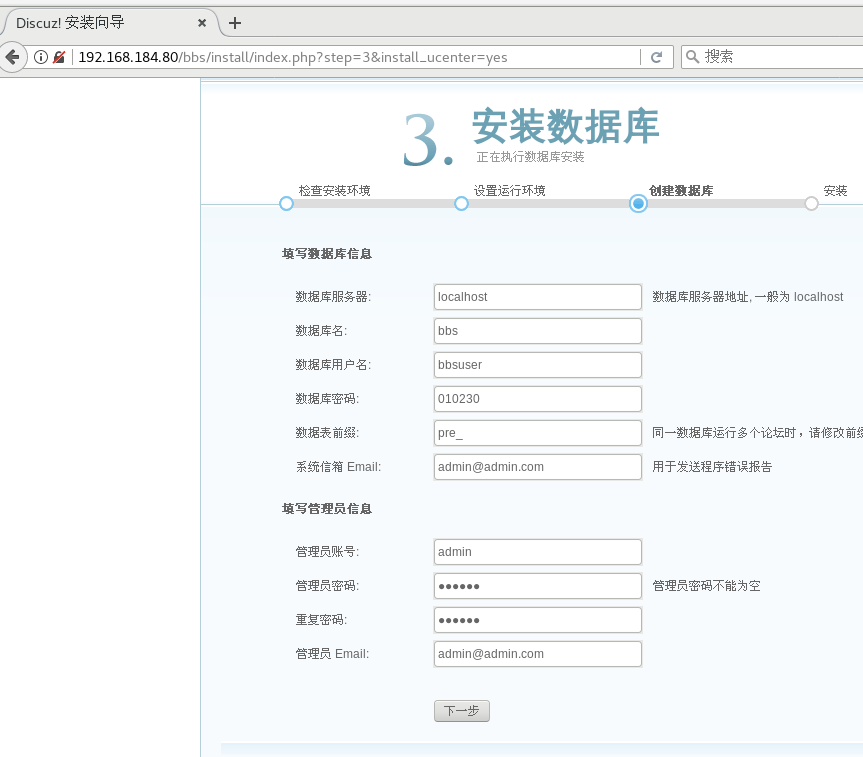
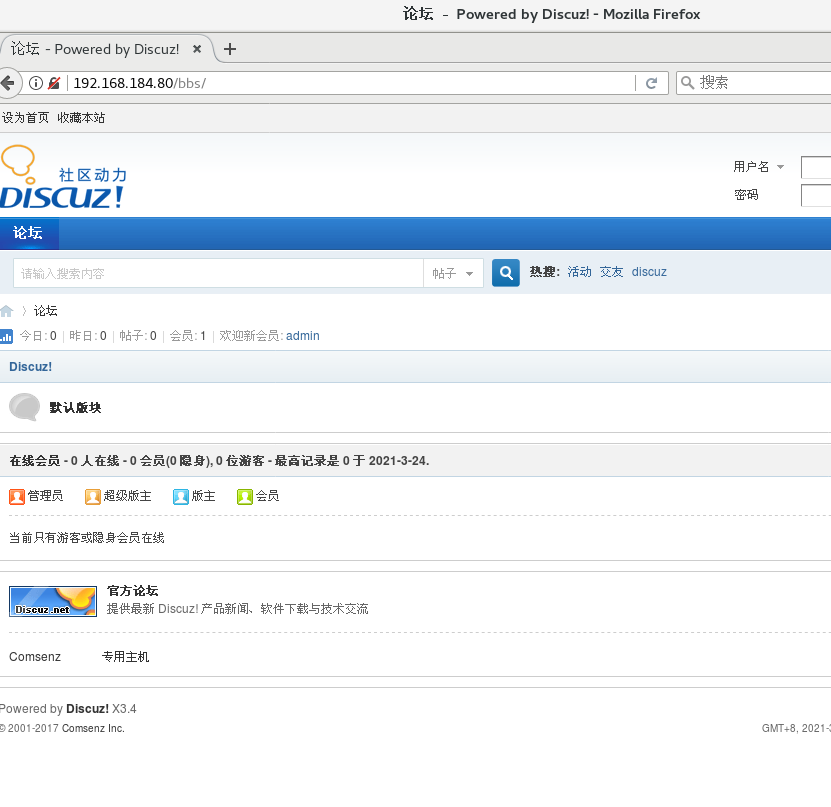
6. Forum background administrator page
